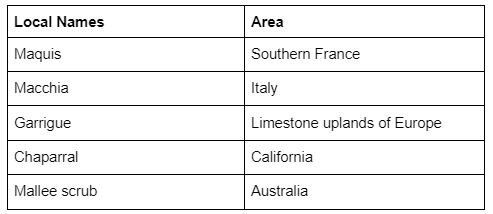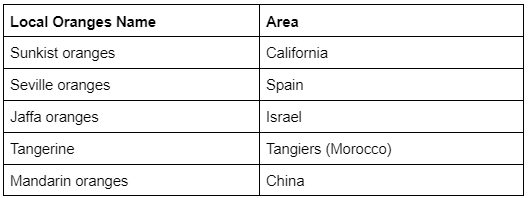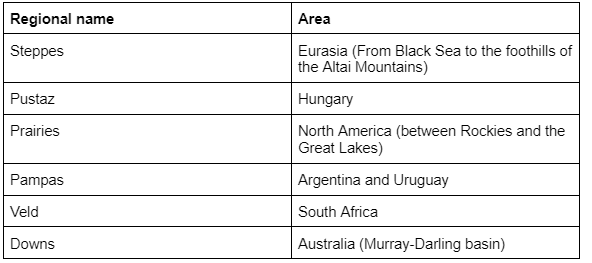Climatic Regions of World: Part-II | 26 Apr 2024
For Prelims: Location, Distribution, Temperature, Precipitation, Natural Vegetation and Economy of different climatic regions of the world.
For Mains: Distribution, Significance, and Impacts of different climatic regions of the world.
Warm Temperate Western Margin (Mediterranean) Climate
- Distribution:
- They are entirely confined to the western portion of continental masses, between 30O and 45O north and south of the equator.
- The basic cause of this type of climate is the shifting of the wind belts.
- The area around the Mediterranean Sea has the greatest extent of this climate while its best developed form is found in central Chile.
- Other Mediterranean climate regions include
- California (around San Francisco),
- South-western tip of Africa (around Cape Town)
- Southern Australia (in southern Victoria and around Adelaide, bordering the St. Vincent and Spencer Gulfs),
- South-west Australia (Swanland).
- Climate:
- A dry, warm summer with off-shore trades:
- In summer when the sun is overhead at the Tropic of Cancer, the belt of influence of the Westerlies is shifted a little polewards.
- Rain bearing winds are therefore not likely to reach the Mediterranean lands.
- The prevailing Trade Winds are off-shore and there is practically no rain.
- Days are excessively warm and in the interiors, prolonged droughts are common.
- At night, there is rapid radiation but frosts are rare.
- A concentration of rainfall in winter with on-shore Westerlies:
- The Mediterranean lands receive most of their precipitation in winter when the Westerlies shift equatorwards.
- In the northern hemisphere, the prevailing on-shore Westerlies bring much cycIonic rain from the Atlantic to the countries bordering the Mediterranean Sea.
- The rain comes in heavy showers and only on a few days with bright sunny periods between them. This is another characteristic feature of the Mediterranean winter rain.
- Bright, sunny weather with hot dry summers and wet, mild winters:
- The climatic features are transitional between those of the Trade Wind Hot Desert in the south and the Cool Temperate Maritime Climate in the north.
- Summers are warm and bright and winters are so mild and cool that many tourists come at all times of the year.
- The sky is almost cloudless and sunshine is always abundant.
- The prominence of local winds around the Mediterranean Sea:
- Many local winds, some hot, others cold, are common around the Mediterranean Sea.
- Sirocco:
- This is a hot, dry dusty wind which originates in the Sahara Desert.
- It is most frequent in spring and normally lasts for only a few days.
- The Sirocco blows outwards in a southerly direction from the desert interiors into the cooler Mediterranean Sea.
- It damages crops, especially wine and olives.
- It is called by many other local names, such as

- In the Adriatic and Aegean Sea, it gathers much moisture causing fog, heavy dew and rain. This may 'blood rain' because the wind is carrying the red dust of the Sahara Desert.
- Mistral:
- Mistral is a cold wind from the north, rushing down the Rhone valley in violent gusts.
- The velocity of the Mistral is intensified by the funnelling effect in the valley between the Alps and the Central Massif.
- A similar type of cold north-easterly wind experienced along the Adriatic coast is called the Bora.
- Tramontana and Gregale are similar cold winds of the Mediterranean Sea.
- Sirocco:
- Many local winds, some hot, others cold, are common around the Mediterranean Sea.
- A dry, warm summer with off-shore trades:
- Natural Vegetation
- Trees with small broad leaves are widely spaced and never very tall.
- The absence of shade is a distinct feature of Mediterranean lands.
- They are xerophytic i.e., drought-resistant plants in an environment deficient in moisture.
- Types of Mediterranean vegetation:
- Mediterranean evergreen forests:
- These are open woodlands with evergreen oaks, of which the cork oaks of Spain and Portugal are the best known.
- The cork oaks are specially valued for their thick barks, used for making wine-bottle corks.
- The jarrah and karri trees are commercially the most important.
- The giant sequoia or redwood is typical of the Californian trees.
- Evergreen coniferous trees:
- These include the various kinds of pines,firs,cedars and cypresses which have evergreen, needle-shaped leaves and tall, straight trunks.
- Mediterranean bushes and shrubs:
- The low bushes grow in scattered clumps and are often thorny.
- The more common species are laurel, myrtle, lavender, arbutus and rosemary, of which a number are strongly scented or perfumed.
- This type of vegetation is also called

- Grass:
- They are so wiry and bunchy that they are not suitable for animal farming.
- Cattle rearing is thus unimportant in the Mediterranean.
- Mediterranean evergreen forests:
- Economy
- The area is important for fruit cultivation, cereal growing, wine-making and agricultural industries.
- Orchard farming:
- The Mediterranean lands are also known as the world’s orchard lands.
- A wide range of citrus fruits such as oranges, lemons,limes, citrons and grapefruit are grown.
- The fruit trees have long roots to draw water from considerable depths during the long summer drought.
- The various Mediterranean oranges are called by different names in their area of production:
- Crop cultivation:
- Wheat is the leading food crop.
- The wheat grown is mainly hard, winter wheat.
- It is suitable for both bread making and other food-products such as macaroni, spaghetti and vermicelli.
- In a few localities, e.g. the Ebro basin in Spain, the Po Valley in Italy and in California, rice has been successfully cultivated and their yields are some of the highest in the world.
- Farms are small but there are also large holdings called :”Haciendas” in Spain.
- Transhumance is widely practised.
- Wheat is the leading food crop.
- Wine production:
- The regions bordering the Mediterranean Sea account for three-quarters of the world’s production of wine.
- Some 85% of grapes produced go into wine.
Temperate Continental (Steppe) Climate
- Distribution
- Temperate Continental (temperate grasslands) are located in the interiors of continents.
- Though they lie in the Westerly wind belt, they are so remote from maritime influence that the grasslands are practically treeless.
- They are called differently in different regions of the world:
- Climate
- Temperature
- The climate is continental with extremes of temperature.
- Summers are very warm and winters are very cold in the continental steppes of Eurasia because of the enormous distances from the nearest sea.
- In contrast, the steppe type of climate in the southern hemisphere is never severe.
- Precipitation
- In its continental position, the annual precipitation of the Steppe Climate can be expected to be light.
- Most of the winter precipitation is brought by the occasional depressions of the Westerlies and coming in the form of snow.
- The maritime influence in the steppe type of climate of the southern hemisphere is even better brought out by the rainfall regime.
- On the eastern slopes of the Rockies in Canada and U.S.A. a local wind, similar to the Fohn in Switzerland, called the Chinook, comes in a south westerly direction to the Prairies and has a considerable effect on the local pastures.
- It is a hot wind and may raise the temperature by 40°F. within a matter of 20 minutes.
- Local farmers welcome the Chinook for frequent Chinooks mean mild winters.
- Temperature
- Natural Vegetation
- Trees are very scarce in the steppes, because of the scanty rainfall, long droughts and severe winters.
- The steppe grass can lie dormant throughout the prolonged drought.
- Towards the equator, the steppe grass becomes shorter and sparser, till it merges into the desert with thorny scrub.
- Their greatest difference from the tropical savanna is that they are practically treeless and the grasses are much shorter.
- Economic Development
- The grasslands have been ploughed up for extensive, mechanized wheat cultivation and are now the ‘granaries of the world'.
- The tufted grasses have been replaced by the more nutritious lucerne or alfalfa grass for cattle and sheep rearing.
- Nomadic herding
- This type of migratory animal grazing has almost disappeared from the major grasslands.
- The herders were wandering tribes e.g. the Kirghiz, the Kazakhs, and the Kalmuk.
- Extensive mechanized wheat cultivation
- The temperate grasslands are ideal for extensive wheat cultivation.
- The cool, moist spring stimulates early growth and the light showers in the ripening period help to swell the grains to ensure a good yield.
- One distinct drawback of this form of extensive mechanized farming is the consequent low yield. But if we consider the yield per man, this is very much higher in the extensive farms.
- They are, naturally, the greatest wheat exporters.
- Pastoral farming
- With the development of refrigerated ships, the temperate grasslands became major pastoral regions, exporting large quantities of beef, mutton, wool, hides, milk, butter, cheese and other dairy products.
- Large estancias (ranches) were established, linked to the frigorificos (meat-packing factories) in Buenos Aires. Bahia Blanca, Fray Bentos and Monteviedeo.
- Nomadic herding
Warm Temperate Eastern Margin (China Type) Climate
- Distribution
- On the east coast of both hemispheres, between 20° and 35° N and S latitude (warm temperate latitudes just outside the tropics), this climate is found.
- It is characterized by a warm moist summer and a cool, dry winter (one exception: winters are also moist in Natal Type).
- Variations of Warm Temperate Eastern Margin Climate
- China type climate
- Intense heating within interiors (Tibet, desert region) sets up a region of low pressure in summer attracting tropical Pacific air stream (South-East Monsoon).
- Monsoon does not ‘burst’ as suddenly, nor ‘pour’ as heavily as in India.
- In winter, there is intense pressure over Siberia and the continental polar air stream flows outwards as the North-West Monsoon, bitterly cold and very dry.
- There is little rain but considerable snow on the windward slopes.
- Gulf type climate
- Monsoonal characteristics are less intense compared to China type.
- There is no complete seasonal wind reversal.
- Hurricanes occur in September and October.
- Natal type climate
- The narrowness of the continents and the dominance of maritime influence eliminate the monsoonal elements.
- The South-East Trade Winds bring about a more even distribution of rainfall throughout the year.
- China type climate
- Climate
- The climate is characterized by dry seasons and wet monsoons, resulting in significant temperature changes between winter and summer.
- Northern winds from high latitude places are chilly and dry in the winter.
- Southern winds from lower latitude sea areas are warm and moist in the summer.
- Temperature
- Temperatures vary between 4° C and 25° C on a monthly basis and are heavily influenced by coastal influences.
- The infiltration of frigid air (Polar Vortex) from the continental interiors can send the temperature down to a freezing point on rare occasions.
- Frosts are rare in the cooler interiors, but they do happen.
- Precipitation
- Rainfall is moderate, ranging from 60 to 150 centimeters.
- Rainfall falls in a fairly consistent pattern throughout the year.
- Summer rain occurs from convectional sources or as orographic rain, whereas winter rain comes from depressions in persistent showers.
- The regions are influenced by moist, marine airflow from subtropical anticyclonic cells during the summer.
- In summer, the regions are under the influence of moist, maritime airflow from the subtropical anticyclonic cells.
- Typhoons (tropical cyclones) and hurricanes are common local storms.
- Natural Vegetation
- It encourages luxuriant vegetation.
- Both evergreen broad-leaved woods and deciduous trees [hardwood] grow in the lowlands.
- Conifers like pines and cypresses, which are essential softwoods, can be found in the highlands.
- A dry season or a cold season has little effect on perennial plant growth.
- Timber
- The forests of China and southern Japan also have considerable economic value and include oak, camphor etc.
- South-eastern Brazil, eastern Paraguay, north-eastern Argentina have Parana pine, and the quebracho (axe-breaker, an extremely hard wood used for tanning).
- Eastern Australia has Eucalyptus forests.
- The Gulf states of the U.S.A. have lowland deciduous forests.
- Agriculture
- Corn
- The humid air, hot summer days, and heavy showers are ideal for the crop.
- It is grown from the Gulf coast to the Midwest south of the Great Lakes, with the highest concentration in Nebraska, Iowa, Indiana, and Ohio's Corn Belt.
- More than half of the world's maize is produced in this region, but just 3% of the crop is exported.
- This is due to the fact that the majority of corn is used to fatten livestock, mostly cattle and pigs.
- The fattened animals are then shipped to Chicago and Cincinnati meat processors to be processed into 'corned beef.'
- Cotton
- The Gulf type of climate is undoubtedly the best for cotton growing.
- Its long, hot growing season with 200 days frost free and a moderately high temperature permits the crop to grow slowly and mature within six months.
- In the very south, in the Gulf-lands, the heavy rainfall damages the lint. This area is therefore less suitable for cotton and is devoted to citrus fruits, cane sugar and market gardening, as in Florida.
- The commercial cultivation of cotton is now concentrated only in the most favorable areas which are the Mississippi flood plains and Atlantic coastlands.
- Tobacco
- Tobacco from Virginia is well-known.
- Tobacco may be successfully grown in several of the eastern states of the United States due to the humid climate, warmth, and well-drained soils of the Gulf states.
- These countries produce more than half of the tobacco used in international trade.
- Corn

 Climate.png)



 Climate.png)
 Climate.png)